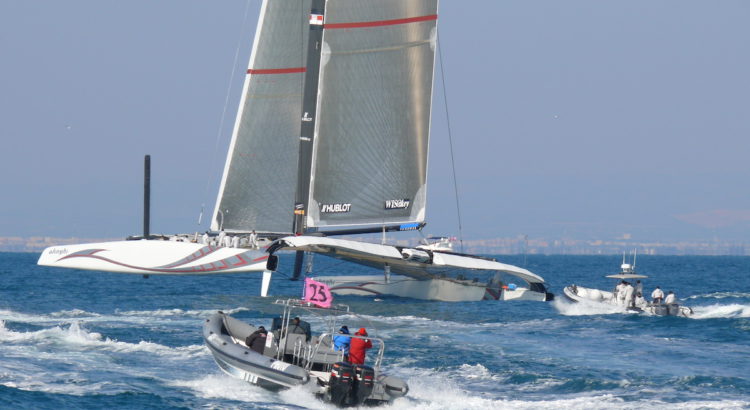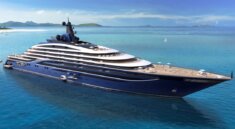The oldest and most prestigious type of yachting competition is the America's Cup race.
The culture of the legendary sailing regattas, as well as the traditions of yachting in general, were formed with the direct participation of royalty and the richest people of their time. After the English King George IV became a member of the Royal Yacht Squadron (Royal Yacht Squadron), and his brother and heir William IV established a prize cup for the winners of regattas in 1834, yachting became a royal sport, sanctioned by the supreme rulers of the state.
Regatta
But it was the era of the reign of the brilliant Queen Victoria, when “the sun never set over the British Empire”, that gave the world the oldest and most prestigious type of yachting competition - the America's Cup race. In 1848, Victoria's husband, King Albert, proposed to arrange a world industrial exhibition in London, which would once again confirm the status of England as the leading power of our time. And since yachting has become an extremely popular sport among aristocrats and not only, even in the period after the end of the Napoleonic wars, it was decided that the regatta in Cowes would become the decoration and culmination of the exhibition. The regatta was supposed to glorify British yachting, but, naturally, sailing athletes from all over the world were invited to participate in it. Commercial and business circles in the US, for obvious reasons, are extremely interested in participating in the exhibition. However, it was a feat for American yachtsmen to participate in the Kauska regatta. In the autumn of 1850, an English journalist invited the commander of the New York Yacht Club, John Cox Stevens, to take part in the regatta. The Americans took a long time to decide which of the boats owned by the yacht club to send to these competitions, until the shipbuilder George Steers announced that he was able to build a new yacht that would be able to outrun the fastest British vessel and in general any yacht in the world. A separate story deserves the story of the search for investors and patrons who would agree to finance such a risky undertaking as the construction of a schooner and its transportation across the Atlantic. Let's just say that in the end, faith in the strength and talent of Steers on the part of American entrepreneurs overcame all doubts. And on June 17, 1850, the legend of sailing, the schooner America, was launched and finally accepted by the commission.
Schooner
Its length along the deck, from bow to stern, was 28.5 m, and together with the bowsprit -38.25 m; width -6.86 m; draft -3.35 m; carrying capacity - 170.5 tons. The height of the front mast is 24.23 m, the main mast is 24.69 m. The hull was built on a frame composed of five types of wood and covered with steel braces. The hull plating is made of light oak, 76 mm thick, and the decks are made of yellow pine, 64 mm thick. The entire bottom, up to a height of 15 cm above the waterline, is upholstered with copper sheets. The hull was painted with tin-colored paint from the outside and white from the inside.
The luxuriously appointed main cabin had 15 berths. The total area of the set of main sails of the schooner "America", made by the best New York master of that time, R. G. Wilson, was 489 sq.m.
In one line, omitting the tense intrigue of the America's struggle with the British yachts, let's say that the schooner won a brilliant victory. Among the British spectators, there was a uniform hysteria when they saw that the British schooner "Aurora" finished 18 minutes after the "America".
The day after the defeat of fourteen of the best English yachts, Lord Paget, Marshal of the Queen's Household, notified Stevens that Victoria, along with her husband the duke, would personally visit the victorious American schooner. It was a huge honor. The victory of "America" significantly raised the prestige of the United States in the eyes of the British Crown and for many years made the Americans leaders in sailing.
Cup
The prize of the Royal Yacht Squadron, won in 1851 by the schooner America, weighed about 3 kilograms. This is a silver vessel with a height of 68 cm, a diameter of 19.3 cm at the base and a circumference of 91 cm at its widest point, with an elegantly curved neck and a carved handle. Its cost in 1851 was only $500. The prize became the property of seven members of the syndicate and has survived to this day. After the death of John Cox Stevens and several other associates, it was decided on July 8, 1857, that the prize be deposited with the New York Yacht Club under certain conditions. The deed of deed stated: “Any yacht club in any country has the right at any time to demand through one or several of its members to conduct a race for this prize on any yacht or other sailing vessel. This ship must have a displacement of not less than 30 and not more than 300 tons, which is determined in accordance with the mandatory customs regulations in force in the country to which this ship belongs. The party claiming the cup race is entitled to play the regatta with the club holding the prize on mutually agreed terms. If no agreement is reached on these terms, then the competition must be held on the normal course used for the annual regattas of the prize-winning club and in accordance with its rules and regulations for regattas. The party making the call must, six months before the deadline, indicate in writing on which day it wishes to start. The notice must indicate the length of the vessel, its tonnage, type of sailing rig and name.
It should be emphasized that the prize must remain in the possession of the club and not of its members or the owners of the winning yacht. The conditions of its award as a challenge prize cannot be changed, for which, in accordance with the above conditions, yacht clubs of all countries are eligible to compete. Through this, the prize will mark a permanent call for friendly international competition.”
The establishment of a challenge international prize called the America's Cup was a significant event in the history of sailing. And although valuable prizes had already been raffled off in regattas before, for the first time such a prize gained international weight, becoming not so much a valuable as an honorary trophy.
Fight for the Cup in the 20th century
The honor of winning the prize has attracted yachtsmen from all over the world for more than a hundred years, although only a few countries are able to participate in the fight for it. The costs associated with these regattas are very high: it has been estimated, for example, that the New York Yacht Club alone spent over $80 million over the next 125 years for this purpose. The same club reigned supreme in the Cup right up to 1983. Although approximately from the 70s of the XX century, there was a serious pressure from the contenders for winning the cup. Applications were received from several countries at once and qualifying competitions were introduced. Only the one who defeated everyone could now face the Defender. Since 1983, the French company Louis Vuitton has become the general sponsor of the qualifying round, establishing the Louis Vuitton Cup for applicants.
For the first time, qualifying competitions between different countries were held in 1970 - France lost its debut to the Australians, who had already entered into the taste of chasing the Cup. But they, in turn, lost to the Defenders, however, saying that the decision to disqualify their yacht in one of the races was unlawful. The struggle for the Cup turned into national politics. A powerful anti-American campaign in the Australian press reminded America of all her sins, which had nothing to do with sailing competitions. In order to avoid political scandals, since 1974 the races began to be held under the leadership of the international jury of the IYPU (International Sailing Association). The distinct national character of the America's Cup races also sounded in the names of the yachts under construction. The French, under the patronage of de Gaulle, performed on the yacht "France". The Swedes, under the auspices of their king, built the yacht "Sweden". Australians - the yacht "Australia" and "Australia II". By this time, the British had left the arena of the struggle for the main prize. It is also characteristic that in the entire history of racing, not a single American club has acted as a Challenger. The cup won by the yacht "America", the whole world is accustomed to consider the "America's Cup" - the country. The defeat of the New York Yacht Club came as a result of an exciting showdown with Alan Bond's Australia II, representing the Royal Perth Yacht Club, with its innovative winged keel. Bond arrived in Newport, Rhode Island, holding a golden wrench with which he swore to unscrew the America's Cup from his "sacred" plinth at the New York Yacht Club. And he succeeded. Melissa H. Harrington wrote about the severity of this loss in the New York Yacht Club's official 150-year history: filled with sad faces and painful feelings of the participants, sincerely and deeply shocked by what happened. No one has ever seen the New York Yacht Club without the America's Cup; what else could we do and experience when he was gone, except sorrow and defeat.
Defenders and Challengers 2008-2009
At the moment, the defender of the America's Cup is the Swiss syndicate Alinghi. In September of this year, the German yacht United Internet Team Germany officially became the fifth contender for the Cup. The 33rd edition of the most prestigious trophy in sailing will take place in 2009 off the coast of Spanish Valencia. A German yacht will take part in it for the first time. This summer, the Alinghi yacht defended the trophy, which was contested by 11 contenders, including a team from Russia. But in the new draw, before the appearance of the German application, there were only four contenders - the Spanish yacht Desafio Espagnol, the New Zealand Team New Zealand, the South African Shosholoza and the debutant from the UK Team Origin.
Ekaterina Sokolova
Based on the materials of the official website of "America`s Cup": www.americascup.com
And chapters from Volodzimierz Glovatsky's book "The fascinating world of sails".




